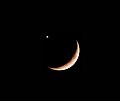File:Voobie - Moon n Venus played hide-and-seek (by-sa).jpg
Voobie_-_Moon_n_Venus_played_hide-and-seek_(by-sa).jpg (657 × 556 pixels, file size: 29 KB, MIME type: image/jpeg)
Nhoroondo ye fayera
Dzvanya pa musi/nguva kuti uringe fayera sekuoneka kwaraita panguva iyoyo.
| Musi/Nguva | Mfananoudoko | Mitandu | Mushandisi | Komenda | |
|---|---|---|---|---|---|
| parizvino | 12:27, 9 Chivabvu 2013 |  | 657 × 556 (29 KB) | Soerfm | Crop |
| 13:56, 8 Chikumi 2012 |  | 798 × 674 (76 KB) | Soerfm | Crop | |
| 11:50, 7 Ndira 2008 |  | 1,200 × 900 (102 KB) | File Upload Bot (Magnus Manske) | {{Information |Description= The moon and Venus came closer, formed a pair and played hide-and-seek Monday evening in a relatively rare astronomical phenomenon, much to the delight of astronomers and stargazers. As the cloud blanket gave way to an azure |
Kushandiswa kwe fayera
The following page uses this file:
Kushandiswa kwe fayera pasirose
Mawiki anotevera ayo anoshandisa fayera iri:
- Hushandiso pa de.wikipedia.org
- Hushandiso pa en.wikiquote.org
- Hushandiso pa ro.wiktionary.org

